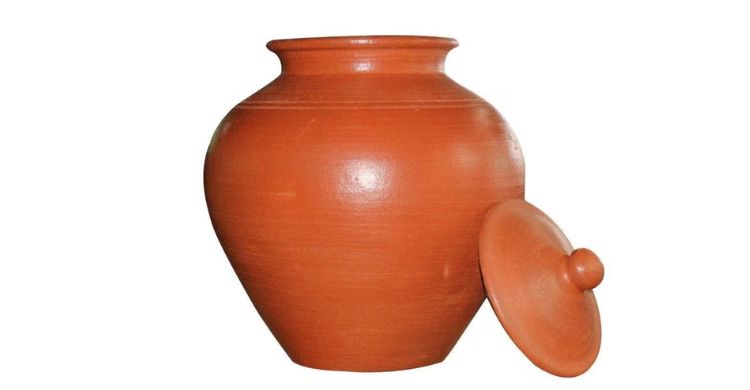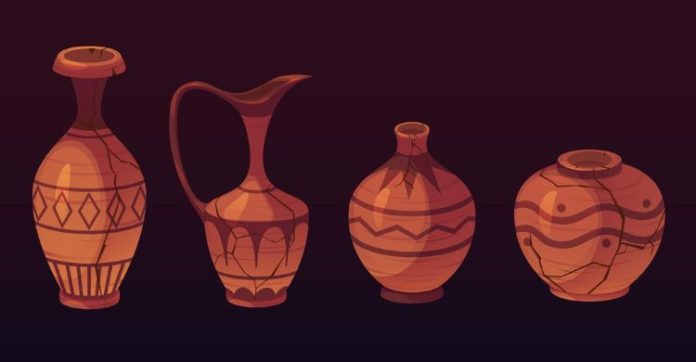As summer arrives with its scorching heat and rising Pitta energy, our bodies naturally crave coolness, calm, and hydration. In the age of bottled water and refrigerators, we often forget the age-old wisdom tucked into every Indian household—the humble matka, or clay pot. Far more than just a water container, it is a natural purifier, body-cooling agent, and digestive ally.
According to Ayurveda, water stored in a clay pot is infused with the earth’s grounding qualities, making it energetically and physically nourishing. The clay pot water benefits go beyond quenching thirst—it balances doshas, enhances metabolism, and supports the body’s natural rhythm.
In this blog, we’ll explore the timeless benefits of earthen pot water, especially during the summer season, and why returning to this traditional practice might just be the simplest and healthiest decision for your well-being.
What is Clay Pot (Matka)?
A clay pot, lovingly known as a matka in India, is a traditional vessel made from natural, unglazed clay. It has been used for centuries to store and cool water—especially during the hot summer months. Crafted by skilled potters using age-old techniques, the matka is more than just a storage container; it’s a symbol of simplicity, sustainability, and the wisdom of living in harmony with nature.
The beauty of a clay pot lies in its porous structure, which allows slow evaporation of water through its walls. This natural process keeps the water cool without refrigeration and maintains it at a temperature that is gentle on the body.
In many Indian households, a clay pot is placed in the kitchen or on the verandah, often wrapped in a damp cloth, preserving water in the most eco-friendly and health-conscious way possible.
In Ayurveda, the matka is respected not just for its practicality but for its earth element (Prithvi), which imparts grounding and balancing energy to the water, making it nourishing for both the body and mind.

Ayurvedic View on Drinking Clay Pot Water
In Ayurveda, water (Jala) is not just a thirst-quencher—it is considered Soma, the cooling, nourishing, and life-giving energy of nature. When stored in a clay pot (matka), water becomes even more therapeutic, as the pot imparts the grounding qualities of the earth element (Prithvi Mahabhuta) into the water.
Know about the Panch Mahabhutas (five elements of nature).
This process not only cools the water naturally but also energizes and balances the three doshas—Vata dosha, Pitta, and Kapha.
During summer, when Pitta dosha—governed by fire and water—increases in the body, symptoms like acidity, heat rashes, irritability, and digestive issues become more common. Drinking clay pot water helps calm aggravated Pitta, thanks to its gentle cooling effect without the shock of cold, refrigerated water.
Moreover, clay is alkaline in nature, while our bodies tend to lean acidic due to modern lifestyles and diets. The water stored in a matka naturally helps neutralize this acidity, supporting Agni (digestive fire) and maintaining an internal pH balance essential for metabolism and overall well-being.
Ayurveda sees this practice as sattvic—pure, harmonious, and beneficial not just for physical health, but also for emotional calm and energetic clarity.
Top Trending Content on hellomyyoga:
Clay Pot Water Benefits
Following are the main benefits of clay pot water during summer:
1. Naturally Cools Water Without Harsh Cold
One of the most well-known matka water benefits is its gentle cooling effect. Unlike refrigerated water, which can shock the throat and digestive system, pot water is naturally cool—thanks to the porous nature of clay that allows slow evaporation.
This keeps the water at a soothing temperature that helps regulate body heat, especially during hot summers, without disturbing internal balance.
2. Balances Pitta and Regulates Body Temperature
According to Ayurveda, summer aggravates the Pitta dosha, which governs heat, metabolism, and digestion. Drinking water from an earthen pot helps balance this excess heat, calm inflammation, and soothe acidity.
One of the most powerful benefits of matka water is its ability to reduce heat-related discomfort like skin rashes, headaches, and irritability.
3. Maintains pH Balance in the Body
Clay is alkaline in nature, while most modern diets tend to be overly acidic. When water is stored in a clay pot, it absorbs the alkaline properties of the clay, helping to neutralize acidity in the body. This is one of the key benefits of earthen pot water—supporting a healthy internal environment and enhancing digestion.
4. Aids Digestion and Improves Gut Health
Another important benefit of pot water is its compatibility with the body’s natural temperature. It doesn’t disrupt the digestive process like chilled water can. Matka water supports Agni (digestive fire) and helps in better assimilation and metabolism of food—especially during meals or after physical exertion.
5. Works as a Natural Purifier
The benefits of matka water also include its natural purification qualities. The porous texture of clay acts as a mild filter, trapping impurities and cooling water through vaporization. It’s a chemical-free, energy-free way to store clean and safe drinking water.
6. Enhances Taste and Increases Water Intake
Water stored in an earthen pot has a naturally sweet, earthy flavor that many find more refreshing than regular tap or bottled water. This subtle difference in taste encourages people—especially children and elders—to drink more water, keeping the body hydrated and detoxified.
7. Boosts Metabolism and Hormonal Balance
Unlike refrigerated water, which is often stored in plastic bottles containing harmful chemicals like BPA, matka water is free of toxins. Clay is rich in minerals that may subtly support metabolism and hormonal health.
This makes the benefits of earthen pot water especially valuable for those experiencing fatigue, digestive sluggishness, or hormone-related imbalances.
8. Eco-Friendly and Sustainable
By choosing a clay pot over a plastic bottle or electric cooler, you support the environment. Clay pots are biodegradable, reusable, and handcrafted by local artisans, making them not just a health choice, but a sustainable one too.
Meditation Topics for You:
Clay Pot Water vs. Refrigerator Water
| Clay Pot Water (Matka Water) | Refrigerator Water | |
| Cooling Method | Natural evaporation via porous clay surface | Artificial cooling using electricity |
| Water Temperature | Mildly cool, soothing to the body | Very cold, often below body’s natural temperature |
| Digestive Impact | Supports digestion, balances Agni | Can weaken Agni, may slow digestion |
| Effect on Doshas | Balances Pitta, calming for summer | Aggravates Vata, disturbs natural temperature balance |
| Alkalinity | Alkaline in nature, balances body’s pH | Usually acidic, especially if stored in plastic bottles |
| Taste | Refreshing, earthy, naturally sweet | Tasteless or metallic, especially from plastic or steel containers |
| Health Risks | None when cleaned properly | Possible BPA exposure from plastic, shock to throat and stomach |
| Eco-Friendliness | 100% natural, biodegradable, zero energy use | Requires electricity, contributes to carbon footprint |
| Cultural Relevance | Deeply rooted in Indian and Ayurvedic tradition | Modern solution with limited holistic value |
| Accessibility | Easily available and affordable | Needs power source and maintenance |
How to Use Clay Pot (Matka) Correctly?
Choose the Right Clay Pot
Opt for an unglazed, natural clay pot—free from chemical coatings or paints. Make sure it has no cracks or odor, and is made from good-quality, sun-dried clay. If possible, buy from trusted potters or Ayurvedic stores.
Clean Before First Use
Soak the pot in clean water for 12–24 hours to remove dust and impurities. Scrub the inside gently using a natural brush or coconut coir. Rinse thoroughly and let it air-dry before filling it with drinking water.
Use Filtered Water
Always fill your matka with filtered or boiled water to ensure safety. While clay can purify mildly, it’s not a replacement for proper water filtration.
Place It in a Cool, Clean Area
Keep your clay pot in a shaded, well-ventilated space, away from direct sunlight and dust. Elevate it slightly on a stand or wooden base to maintain airflow beneath.
Change Water Daily
Refill your pot every 24 hours to keep the water fresh and cool. Avoid letting water sit for more than 2 days, especially in humid climates.
Clean the Pot Regularly
Clean your clay pot once every 3–4 days using warm water and a soft brush. Avoid soap or detergents—they can seep into the pores and affect taste. Use a paste of baking soda or lemon juice occasionally for deeper cleaning.
Don’t Use for Milk or Juices
Clay pots are best suited for water. Avoid storing milk, juice, or flavored liquids as they may ferment or leave residue inside the pores.
Replace When Needed
A well-maintained matka can last 3–6 months. Replace if it develops cracks, smells odd, or the water starts tasting different.
FAQs About Clay Pot Water Benefits
Clay pot water naturally cools the body, balances Pitta dosha, supports digestion, maintains pH levels, and hydrates gently without the shock of refrigerated water.
Yes. Clay pot water is mildly cool and body-friendly, while fridge water is too cold, may disturb digestion, and lacks the earthy, alkalizing benefits.
Yes, if you use filtered water, clean the pot regularly, and buy from a reliable source. Always check for cracks and odor before use.
Clay pots have mild natural filtration properties due to their porous structure, but they do not replace proper water purification methods like boiling or filtering.
Yes. Clay is alkaline in nature and helps neutralize excess acidity in the body, providing relief from acid reflux and indigestion.
Absolutely. Matka water supports digestion by maintaining body temperature and aiding smooth functioning of the gut, without shocking the digestive fire like cold water.
It especially calms aggravated Pitta, supports Kapha by being grounding, and doesn’t disturb Vata, making it suitable for all doshic types.
Water should ideally be consumed within 24–36 hours. Refresh daily for best taste and safety.
Yes, it’s safe and healthy for children as it’s naturally cool and free from harmful chemicals.
Absolutely. It’s gentle on digestion and ideal for elders, especially those sensitive to cold or suffering from acidity or weak digestion.
Yes. By keeping the body cool and toxins in check, it indirectly supports clearer, healthier skin in summer.
It has a subtle, earthy, refreshing taste that many find superior to tap or bottled water.
At least every 3–4 days during regular use. Rinse daily when refilling.
Yes. It supports gut health, regulates body temperature, and avoids chemical exposure from plastic bottles—all aiding better metabolism.
Yoga Information:
Yoga for Health:
| Yoga for High Blood Pressure | Yoga for Anxiety | Yoga for Metabolic Syndrome |
| Yoga for Bipolar Disorder | Yoga for Endometriosis | Yoga for Lower Back Pain |
| Yoga for Depression | Yoga During Periods | Yoga for PCOD |
Ayurveda Content to Read:
Important Mental Health Content For You:
Explore by Topics:
Pranayama Information:



